
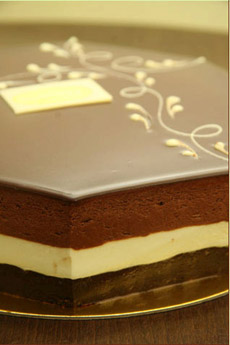 Triple Chocolate Cake is made with three flavors of chocolate mousse. Available from FinancierPastries.com. Triple Chocolate Cake is made with three flavors of chocolate mousse. Available from FinancierPastries.com.
June 2008
Last Updated September 2025
|
|
All Types Of Cake
Cake Glossary Page 8: Torte & Other Cake Terms From T To Z
Find all types of cake here on Page 8 of our eight-page Cake Glossary. Learn about tarte Tatin, tiramisu, torte, tres leches cake, and more. Click on the links below to visit other pages, or go to the overview. Check out our many other delicious food glossaries, including pies and pastries.
Click on a letter to go to the appropriate glossary page.
a b c d e f g h i j k l m n o p q r s t u v w x y z
This glossary is protected by copyright and cannot be reproduced in whole or in part.
You are welcome to link to it.
TARTE TATIN
Some people think of Tarte Tatin as an upside-down cake. It is similar, but it is a one-crust fruit pie, invented by accident in France in the early 1880s. It is served upside-down; the apples are on the bottom with the crust on top.
The Tatin sisters, Caroline and Stéphanie, owned the Hotel Tatin in Lamotte-Beuvron, southwest of Paris in the Loire Valley, not far from the town of Chambord. It was a favorite stop for sportsmen during the hunting season.
One story says that a tired Stéphanie, preparing an apple tart, accidentally left the apples cooking in sugar and butter for too long on the stovetop. In an attempt to salvage the dessert, she placed the pàte brisée (today, puff pastry is used) atop the apples in the skillet and baked it in the oven.
The tart came out of the oven with the apples deeply caramelized. Customers loved it, and the Tarte Tatin was born.
It is now also made with different fruits such as banana, peach, pear, stone fruit, the apple-like quince, and with trendy ingredients such as salted caramel.
Here’s a recipe for Quince Tarte Tatin.
Savory versions are also made, such as beet or onion tatin. Here’s a recipe for beet tarte tatin.
|
|
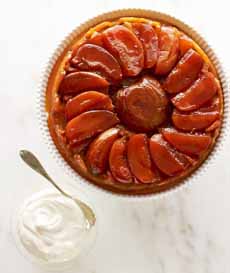
Conventional Tarte Tatin. Here’s the recipe from Martha Stewart (photo © Martha Stewart).
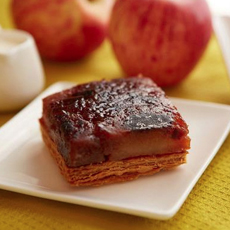
Tarte Tatin cut from a sheet pan (photo © Chocolate Lab | San Francisco [permanently closed]).
|
Another legend has it that the flirtatious Stéphanie became distracted by a handsome hunter in the restaurant. Rushing back to the kitchen, she tossed some apples, butter, and sugar in a pan. She then hurried back out to help her sister in the dining room, forgetting the pan atop the hot stove. After a while, the aroma of caramel drifted from the kitchen, and Stéphanie ran back to find the apples bubbling on the stove. In an attempt to salvage the dessert, she placed a layer of pàte brisée over the caramelized apples, browned the crust in the oven, and then turned it upside down to serve. The Hotel patrons loved it.
TEA CAKE or TEACAKE
A name given to many different types of cakes or cookies that are served with afternoon tea. Each country and region has its own favorites.
The commonality is that the tea cakes are finger food. They range from miniature loaf cakes to raisin buns to a Mallomar-type cookie (in Northern Ireland) to a sugar cookie (in the southern U.S.) to the Victoria sponge (jam and whipped cream sandwiched between two sponge cakes) enjoyed by Queen Victoria with her tea.
|
|
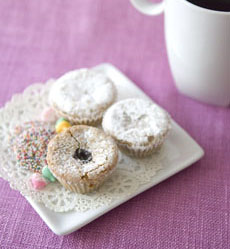
Tea cakes. Photo by Corey Lugg | THE NIBBLE.
|
10x SUGAR
The industrial term for confectioners’ sugar.
TENNESSEE CANASTA CAKE
A dark chocolate cake of four layers with a vanilla cream filling. It is iced with chocolate buttercream, to which 6 tablespoons of cola and a cup of chopped pecans are added.
THOUSAND LAYER CAKE or TWELVE LAYER CAKE.
Thousand-layer cakes are like thousand-year-old eggs:* The number is highly exaggerated (the cakes often have 12 layers, and the preserved duck eggs are no more than 100 days old). But that doesn’t take away from the enchantment.
The thousand-layer cake recipe originated in the colonial Dutch East Indies, now Indonesia; the Dutch name is known as spekkoek. Originally flavored with local spices, they are now made in a variety of flavors.
See our review of Euforia Confections’ thousand-layer cake. For other many-layered cakes, see Mille Crêpes Cake and Smith Island Cake.
|
|
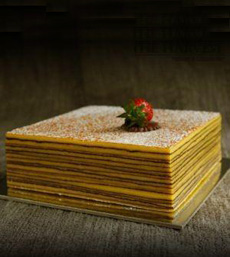
Thousand Layer Cake, also called Twelve Layer Cake. Photo courtesy Euforia Confections.
|
TIRAMISU
While there are many variations of this Italian recipe, it is typically composed of layers of sponge or ladyfingers, soaked in espresso liqueur or a similarly flavored syrup, and layered with a mascarpone cheese and custard mixture; then dusted with cocoa or shaved chocolate.
The name means “pick me up,” from the espresso flavoring. Here’s the history of tiramisu.
It is sometimes called an Italian trifle, although it is much lighter than a traditional trifle.
|
|
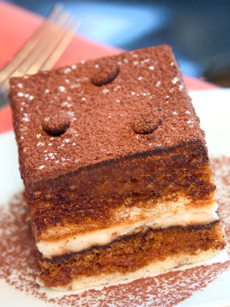
Tiramisu. Photo by Kelly Cline | IST.
|
TORTE
Torte is the Austrian, German, and Hungarian word for cake. Tortes are always round and generally shorter and wider than cakes, as well as denser and less delicate. This denseness and shortness are often due to the use of ground nuts in place of a portion (or all) of the normal amount of flour.
Tortes are made without chemical leaveners, using egg foams for lightness. In addition to the fillings traditionally used by American, British, and French cakes, tortes also use marzipan (ground almond paste) as a filling.
|
|
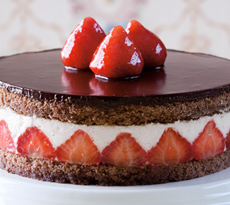
Strawberry coconut torte. Get the recipe. Photo courtesy Lindt USA.
|
|
What’s the difference between a cake and a torte? It depends on whom you ask.
But essentially, torte is the German word for cake. As opposed to a pound cake or a more casual cake, a torte denotes a rich, dense cake made with many eggs and little or no flour, using ground nuts (and sometimes breadcrumbs) for texture.
Tortes are also shorter and wider—often no more than 2-1/2 inches high, and 10 to 12 inches in diameter—the original style.
Today, many bakers and recipe writers call their cakes “tortes,” possibly in order to make them sound different and more exciting. More accurately, in the U.S., the term should be used to describe a shorter, wider cake.
|
|
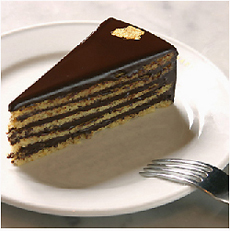
Hazelnut torte, thin layers of hazelnut cake and bittersweet ganache, by pastry chef Pierre Rebout. Photo courtesy Wallse | New York City.
|
A tart is not a torte! A is not a cake. It is a filled pastry shell. The word is misused by people who don’t know better. Just because you see it in print online doesn’t make it correct!
TRES LECHES CAKE
A sponge cake that is baked, perforated, and soaked in three different milk products (the tres leches—evaporated milk, sweetened condensed milk, and whole milk) such that the cake absorbs the milk.
It is a favorite cake for celebrations throughout Central America and has become popular in the U.S. (Jenna Bush Hager served it for her wedding cake). It is served with whipped cream.
Tres leches cake most likely originated in Nicaragua in the early 1900s. The recipe was printed on the label of sweetened condensed milk cans to spur sales of the product.
|
|
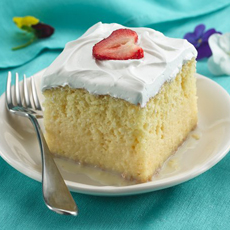
Tres leches cake. Photo courtesy Betty Crocker.
|
TRIFLE
A trifle is a multilayered dessert that begins with a layer of cake on the bottom, often split and sandwiched with jam; the cake has alternating layers of custard, fruit, and whipped cream.
Spirits that complement the fruits are frequently used to flavor the cake layers (sherry, Grand Marnier, liqueurs). It is generally composed in a glass bowl or individual goblets so the beauty of the individual layers can be enjoyed.
Today’s elaborate trifles—which are hardly trifling—began as more humble desserts many centuries ago in England and began to evolve to their current fancy state in the mid-18th century.
|
|
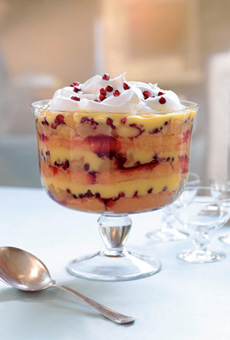
Trifle. Photo courtesy Pom Wonderful.
|
TUBE PAN
A tall, round pan with a tube-shaped aperture in the center that leaves a hole in the middle of the cake. Generally used for light, airy cakes like angel food, the center tube enables the cake batter to rise higher. For the most flexibility, buy one with a removable bottom.
A Bundt pan, which also has a hole in the center, isn’t a substitute for the same effect because it is made to create a shorter, dense cake, and the fluted sides can make releasing the cake more difficult.
|
|
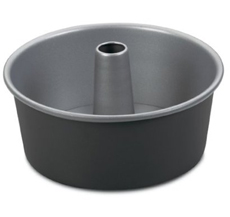
Tube pan. Photo courtesy Cuisinart.
|
TUNNEL OF FUDGE CAKE
The Tunnel of Fudge Bundt cake placed second in the 1966 Pillsbury Bake-Off. The cake was created by Ella Rita Helfrich of Houston.
Adding a circle of Pillsbury Double Dutch Frosting Mix on top of the batter, halfway through, created a moist circle of “fudge” in the center of the cake. Bundt pan sales jumped exponentially, and like other recipes, Tunnel Of Fudge became all the rage.
The frosting mix was discontinued, and subsequent recipes were re-worked with cocoa powder and later, chocolate pudding mix. The first prize winner? Golden Gate Snack Bread, a yeast bread made with instant flour, processed cheese spread, dry onion soup mix, and butter.
|
|
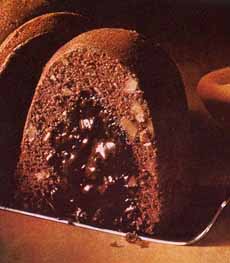
Tunnel Of Fudge Cake. Photo courtesy Cooks Info.
|
UPSIDE-DOWN CAKE
This cake was originally made in a skillet and called skillet cake; fruit was set on the bottom with the batter poured on top. The baked cake is inverted, and the fruit that was once at the bottom forms a decorative topping.
When canned pineapple rings became available in the first half of the 20th century, Pineapple Upside Down Cake became the rage—often with maraschino cherries in the center of the pineapple rings.
As the recipe evolved, cooks put their skillets in the oven to bake. Nordicware, creator of the bundt pan, created a special round pan with indentations for the pineapple slices, guaranteeing an even presentation. Upside Down Cake is related to the Tarte Tatin, an accidental upside-down pie from 1880s France.
Check out these upside-down cake recipes...and an upside-down pie:
Also see Tarte Tatin, above: an upside-down tart.
|
|
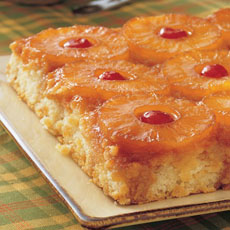
Top: Pineapple upside-down cake. Photo © Betty Crocker. Here’s the recipe.
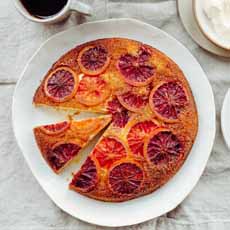
Blood Orange Upside Cake. Here’s the recipe (photo © Good Eggs).
|
VACHERIN
A vacherin is constructed from separately baked meringue rings or discs that are stacked and traditionally filled with whipped cream, ice cream, or both, and often fresh fruit. The ice cream version is called vacherin glacé.
The meringue rings create an enclosed space or "container" - it's more architectural than just layers stacked flat.
Vacherin, like Pavlova and Schäum Torte, is actually not a cake. With all three, the
classification gets tricky:
- Why it's not quite a cake: Cakes typically involve a batter of flour, fat, and eggs baked together to create a risen, spongy structure. Vacherin has none of that; it’s just meringue (egg whites and sugar).
- Why it's not quite a pastry: Pastries usually involve dough, e.g. laminated dough (like croissants), choux pastry (like éclairs), or pie/tart dough. Meringue doesn’t fit into traditional pastry categories.
- What it actually is: Vacherin is fundamentally a meringue-based dessert. In French culinary terminology, meringues are their own category of confection.
For the sake of convenience, you may see it referred to as a meringue cake or a meringue torte, and find it in the cake or pastry section of a cookbook; but that’s more about the convenience of categorization than the strict culinary definition.
The same ambiguity applies to Pavlova and Schäum Torte. All three are meringue desserts that don’t fit neatly into traditional cake or pastry categories. They’re essentially in their own special category of baked egg white confections.
|
|
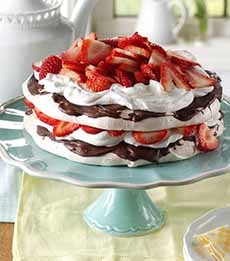
A two-layer strawberry-chocolate vacherin, called a “meringue torte” by some American bakers. Here’s the recipe (this photo and the next © Taste of Home).
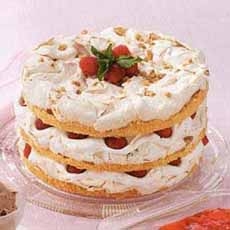
A three-layer vacherin. Here’s the recipe.
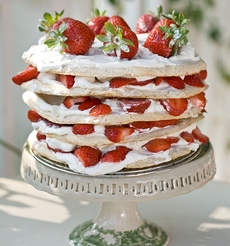
A three-layer vacherin |
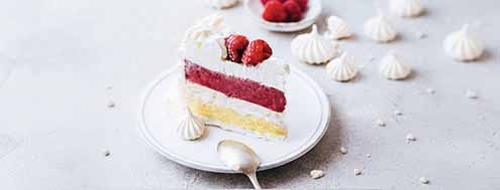
Vacherin glacé, like an ice cream cake, but with meringue layers instead of cake. Here’s the recipe (photo © Lilie Bakery).
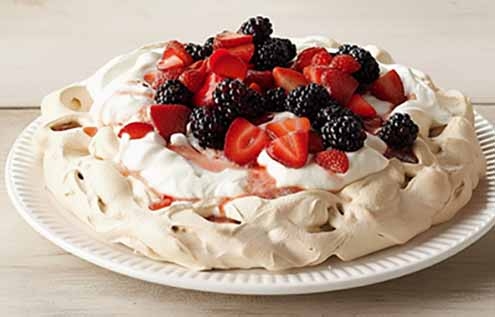
Here’s a Pavlov, looking much like a single-layer vacherin (Gemini photo).
VICTORIA SANDWICH CAKE or VICTORIA SPONGE
This tea cake was particularly enjoyed by Queen Victoria (1891-1901). It was a sandwich of two sponge cakes, filled with layers of jam and whipped cream.
After her husband, Prince Albert, died in 1861, the Queen spent time in retreat at the Queen’s Residence (Osborn House), her summer home on the Isle of Wight. According to historians, it was here that the cakes were named after her.
However, credit for creating the tradition of tea is owed to Anna, Duchess of Bedford (1788-1861), one of the Queen’s ladies-in-waiting. There was a big stretch between lunch at noon and dinner at eight, and the duchess became famished at about four in the afternoon.
|
|
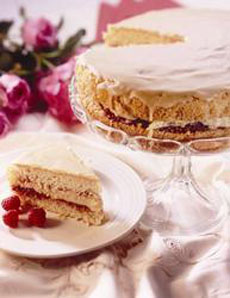
Get the recipe for this Victoria Sandwich Cake from Billington’s Best Of British Recipes.
|
At first, she had a pot of tea and a few breadstuffs brought to her dressing room. But later, she invited friends to join her for a late afternoon meal of small cakes (which became known as tea cakes), bread and butter sandwiches, assorted sweets, and a formal tea service. The practice of inviting friends to come for afternoon tea was quickly picked up by other social hostesses, including Queen Victoria.
VIENNESE SPONGE
A Viennese sponge (Wiener Masse) differs from the French sponge (genoise) in several ways. (1) It uses the separated egg method, where egg whites are whipped separately to stiff peaks, and then folded into the batter. Genoise uses the whole egg method, where whole eggs and sugar are warmed and whipped together until thick and pale (the “ribbon stage”). (2) Viennese sponge often includes a small amount of butter or oil for richness, whereas genoise contains no fat. The result is that the Viennese sponge has a lighter, more airy texture; the separated egg whites create more lift and a softer crumb. Genoise has a denser, more compact texture. It’s still light and has a finer crumb. (3) Viennese sponge sometimes includes a touch of vanilla or lemon zest. Which should one use?
|
|

Viennese sponge. Here’s a recipe (photo © Combine Good Flavors).
|
- Viennese sponge is generally easier to make (since you don’t need to warm the eggs and is more tender and cake-like.
- Genoise is more flexible and thus better for rolling (e.g., roulades).
VIENNOISERIE
Viennoiserie is not cake but laminated pastry dough, an expensive (because of the amount of butter needed) and time-consuming process (because the butter is folded in between layers of dough). This technique is used to make the flaky “breakfast pastries,” croissants, Danish, and brioche. It is a marriage between traditional bread baking and sweet pastry baking.
You can see the striations, or layers, of pastry when you look at the top of the Viennoiserie or when you cut into it, and you can pull apart the layers of the baked dough.
According to legend (subsequently disproved), the croissant was created to commemorate the defeat of the Turks in Vienna; hence, the group of specialty breads became known as Viennoiserie. See croissant in our Bread Glossary for the accurate history.
|
|
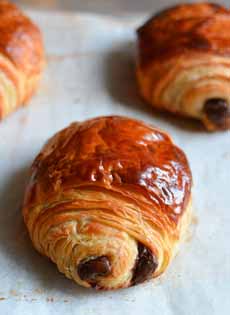
You can see the layers of laminated dough. Photo courtesy Sprinkled With Jules. Here’s the recipe.
|
WACKY CAKE, CRAZY CAKE, DEPRESSION CAKE, or WAR CAKE
Wacky cake was a Depression-era recipe made with inexpensive ingredients: no eggs, butter, milk, or cream. It was also made during World War II when these ingredients were rationed, too costly, or simply unavailable. Typical ingredients were flour, sugar, baking soda, salt, water, oil, and vinegar. If you had cocoa powder, you could make chocolate cake.
Vegetable oil or melted shortening replaced butter, vinegar and baking soda created the chemical reaction needed for leavening (replacing eggs), and water substituted for milk. Adding to the wackiness was the mixing method. Instead of creaming butter and sugar or beating eggs, the dry ingredients were added to a bowl or directly to the baking pan, and wells were created to add the wet ingredients. Then the mixture was stirred together.
The result was quite good: a tender, moist crumb with a texture that was surprisingly similar to a traditional cake. Thanks to the oil, it stayed fresh longer than butter-based cakes.
Wacky cake is still made today, a vegan cake that many don’t know originated in hardship.
|
|
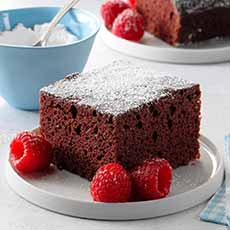
Here’s a recipe for chocolate wacky cake (both photos © Taste Of Home).
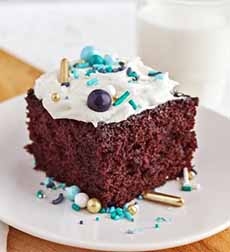
The same cake, frosted and garnished.
|
WAFFELTORTE
A Viennese specialty made from several layers of crunchy waffles and nougat. You can order them online from Demel in Vienna (and their Sachertorte as well).
The concept of layering wafers or thin biscuits with cream or chocolate is found in various European pastries. The Waffeltorte is a delightful example of this, often including nuts as well. It’s part of the elegant and indulgent Austrian dessert culture.
|
|
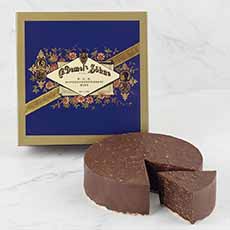
Waffeltorte (photo © Demel | Vienna).
|
WEDDING CAKE
In America today, a wedding cake is typically a large, multi-tiered cake with white icing, although the cake and filling inside can be whatever the bride desires (First Daughter Jenna Bush chose a tres leches cake).
Some brides choose a very plain cake decorated simply with fresh flowers, while others like elaborate decor with spun sugar flowers, birds, and iconic columns holding up the layers.
The cakes can be covered in buttercream, royal icing, or fondant. Traditionally, a ceramic bride and groom have topped the cake, but often tradition gives way to flowers or other decorations.
As can be seen on the Food Network, those who can afford designer cakes can have majestic works of art that don’t look like wedding cakes, but are cake sculptures that represent anything from where the bride and groom met (an art exhibit at a museum) to their hobby (flying planes or scuba diving) to a fantasy of a princess being rescued from the tower by a prince on horseback.
|
|
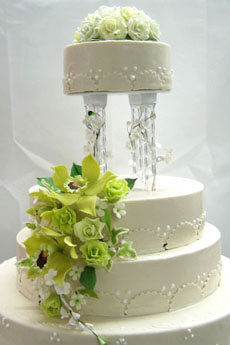 Wedding cake. Photo courtesy FinancierPastries.com. Wedding cake. Photo courtesy FinancierPastries.com.

We love this approach where the bride and groom fall off their cake (photo © Cupcake Castle).
|
YEAST CAKE
Today’s coffee cakes and crumb cakes are popular examples of yeast cakes. Wild yeast was the original raising agent; after the yeast was cultivated*, yeast cakes remained the earliest type of what we now know as the modern cake.
By the mid-eighteenth century, the discovery of beaten eggs as a raising agent led to much more elaborate baking, and the more primitive yeast cakes fell out of favor. The beaten batter was poured into molds as simple as tin hoops set on parchment paper on a cookie sheet (from which modern cake pans developed).
|
|
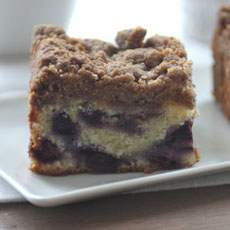 Blueberry crumb cake. Photo courtesy BellaBaker.com. Blueberry crumb cake. Photo courtesy BellaBaker.com.
|
__________________
*In 1859, Louis Pasteur identified that yeast was a living organism and the agent responsible for alcoholic fermentation and dough leavening. He discovered that yeast feeds on the starches in flour, producing carbon dioxide. The carbon dioxide expands the gluten proteins in the flour, and the gluten proteins cause the dough to expand and rise. Nine years later, Fleischmann’s Yeast was founded, and the modern baking era, with commercially available yeast, was born.
YULE LOG
See bûche de noël.
The general shape is also known as a roulade, Swiss log, or Swiss cake roll, and jelly roll (when rolled with jam or jelly), among other names†, and is enjoyed year-round.
______________
†Biskuitrolle (Germany, Switzerland), Brazo de Reina [Queen's Arm] or Brazo de Gitano [Gypsy's Arm] (Latin America and Spain), Kääretorttu (Finland), Pionono (Latin America, especially Argentina, Peru, and Colombia, often filled with dulce de leche), Rocambole (Brazil), and Rulltårta (Sweden), among others.
Go To The Article Index Above
|
|
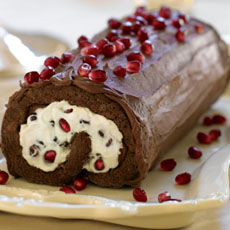
A yule log, or bûche de Noël. Here’s the recipe (photo © Pom Wonderful).
|

|






























